Building Bridges at VBG
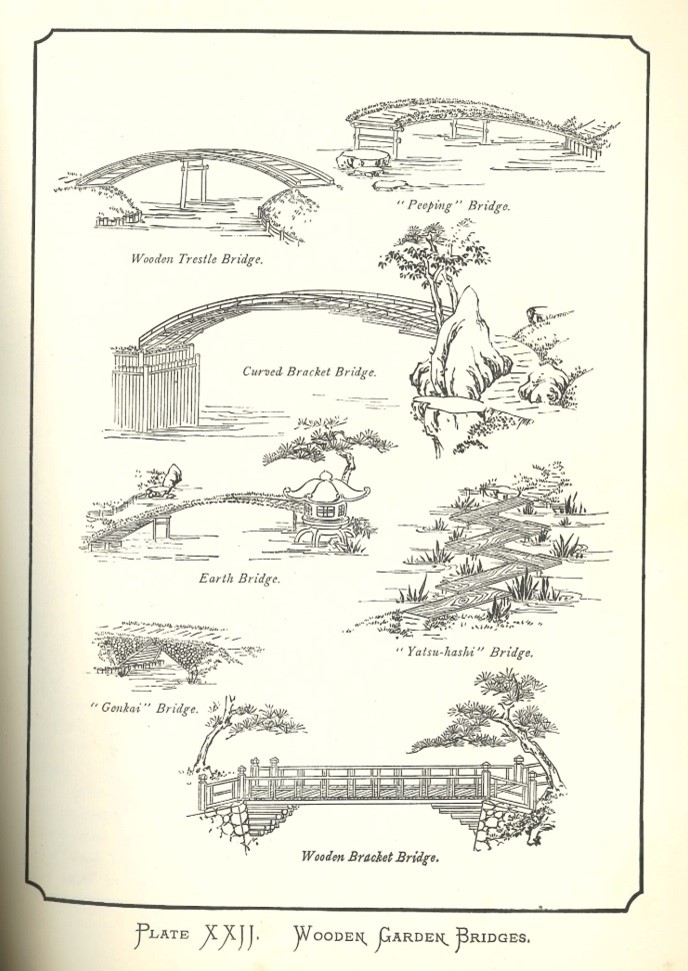 At the western end of our Further East gardens, several examples of bridges can be found with Japanese influence in their design. Over time the bridge below-left, based on the “Genkai” style in Josiah Conder’s Landscape Gardening in Japan (1964 – seen left), had lost its timber stack base. This Winter, VBG gardener John Cronin has rebuilt this feature.
At the western end of our Further East gardens, several examples of bridges can be found with Japanese influence in their design. Over time the bridge below-left, based on the “Genkai” style in Josiah Conder’s Landscape Gardening in Japan (1964 – seen left), had lost its timber stack base. This Winter, VBG gardener John Cronin has rebuilt this feature.
The bridge has an illusion, that it is supported by faggots of bundled logs. These Genkai bridges were traditionally used where the ground is too hard to sink pilings. This ground was certainly very hard in 2007 when these bridges are first constructed.
The Japanese conception of a garden bridge is not, by any means, that of a quick and direct passage. Some Japanese wooden bridges are built to take several right-angled turns. Our bridge complex includes these zig zags, and the handrails act as a device to hold Wisteria. A complex example can be seen at Hama Rikiu, in Tokyo. At VBG our bridges and Wisteria are far from the Japanese ideal but give an architectural feel.
Further along this area John has been working on cleaning up the dry stream that runs beneath another wooden bracket bridge (pictured below-right), or rankan-bashi. These bridges are given their name by the extending brackets extending from each edge, seeming to support the bed of the bridge. This is copied from the Conder illustration, as is the double banister arrangement.
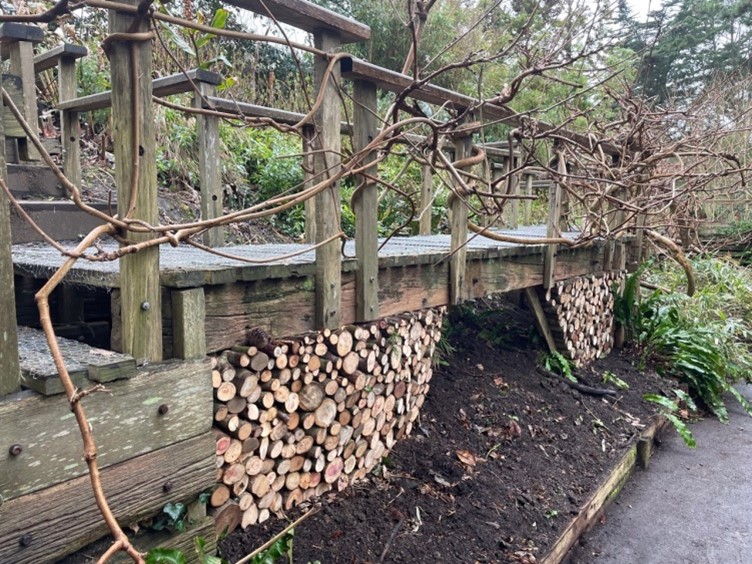
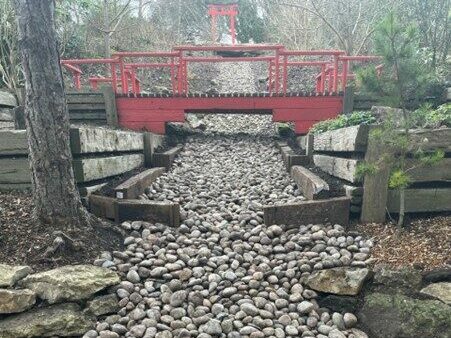
Planted along the front edge are some still young examples of the archetypal Japanese Black Pine, Pinus thunbergia (pictured below). Grown from seed in 2003, these two needled pines are still comparatively tiny, but will one day become part of a dramatic landscape.
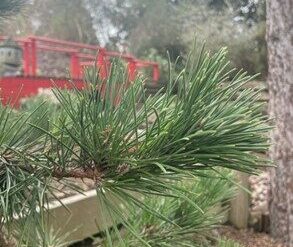
The Legend of the Blue Flower
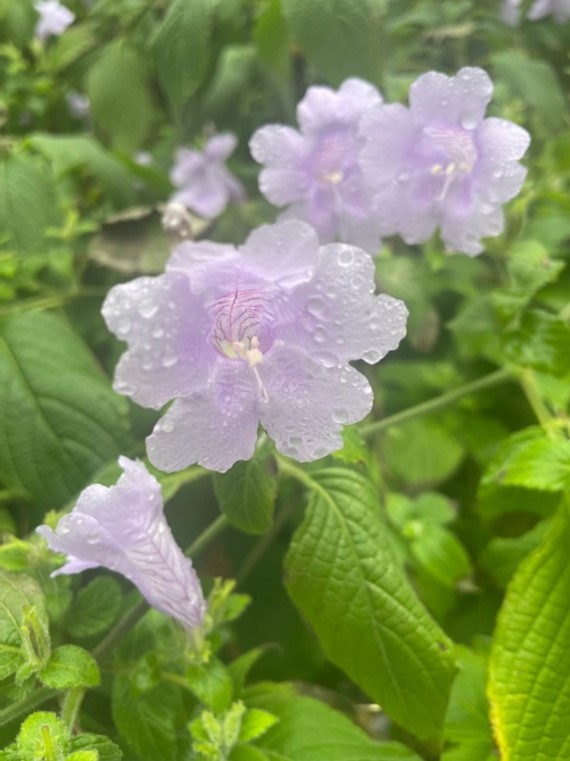 Whilst in this area there is a stunning blue flowered herbaceous perennial to be seen. The precise origins of this plant are somewhat unclear, and link to what has become an increasingly well embroidered legend. Years ago, in Cornwall lived an enigmatic – some said eccentric – man named Edward Needham. Needham was a man of considerable means, but lived a life that on the face of it was of another. He gardened not for a living, but as a passion for plants. He didn’t need to garden to live, to pay the bills, but carried himself, and resembled a man, who did. Apocryphally, so the story goes, one day Needham was gardening, and took harsh criticism from his boss for some trivia or other. Needham put down his wheelbarrow and walked off. He didn’t return. He went to the Far East to look at plants in the wild and bring them back to his own private garden.
Whilst in this area there is a stunning blue flowered herbaceous perennial to be seen. The precise origins of this plant are somewhat unclear, and link to what has become an increasingly well embroidered legend. Years ago, in Cornwall lived an enigmatic – some said eccentric – man named Edward Needham. Needham was a man of considerable means, but lived a life that on the face of it was of another. He gardened not for a living, but as a passion for plants. He didn’t need to garden to live, to pay the bills, but carried himself, and resembled a man, who did. Apocryphally, so the story goes, one day Needham was gardening, and took harsh criticism from his boss for some trivia or other. Needham put down his wheelbarrow and walked off. He didn’t return. He went to the Far East to look at plants in the wild and bring them back to his own private garden.
True or not, Needham acquired a collection of plants that became breath-taking, but unobtainable. In private hands, however purloined, they were not to be seen easily. For the sake of balance, it should be said many items made their way into wider cultivation and can be found in Cornish Gardens, sometimes by dint of secret night raids with secateurs by other wild eyed plant collectors. It is rumoured that upon Needham’s death, he was hardly departed when near wholesale incursion by plant raiders took place.
From these raids may, or may not, have cuttings from a certain plant pictured above ended up in the private collection of a nameless plantaholic near Penzance. This hoarder’s private collection was, and is, extraordinary; yet he will release none of it for science, prestige, honour, or any amount of money. So, another fairy story goes, a former member of VBG staff visited this private collection, and under subterfuge and misdirection acquired a cutting of a plant growing under a Cypress tree windbreak. It was half dead (like most of the private collection) but had a tubular blue flower in March. An unusual time of year for any flower, let alone a blue one. It returned to VBG in a supermarket carrier bag, tucked above the driver’s cab of the Mercedes van. At VBG, nobody knew what this scrap was, but it became mixed into the burgeoning collection of plants destined for the South African Terraces.
It was planted out in 2005. Slow to establish, it went unnoticed for several years, and had a hiding from frosts to boot. It eventually came to attention when established as a large plant with downy leaves, flowering all winter long in a delicate shade of blue. Identification as a member of the Acanthaceae family was straightforward and clear from a mile away, as was its standing out as an alien within a South African landscape. The Acanthaceae family are mostly tropical, centered in the US, Australia and Mediterranean, not so much in sub-Saharan continental Africa. Drawing the attention of Colin Pope, the plant was propagated and transposed to the VBG nursery, and unceremoniously removed from South Africa.
At the time, Colin was following up on the identification of some Strobilanthes plants at VBG, some of which had begun to “turn up” in various locations, gardens and elsewhere, on the Isle of Wight. Perusing the handwritten and often photocopied list of plants at VBG from the Hillier era showed some Strobilanthes whose diagnosis didn’t quite match the plants in the ground. Colin brought in the expertise of John Wood from the Department of Plant Sciences at Oxford University to explain the complex and mentioned in passing our strange plant. With piqued interest, Wood diagnosed our plant as Strobilanthes glutinosa from the north Indian Himalayas, extending to Nepal. One of the areas Needham disappeared into, after dropping his barrow all those years ago.
Chris Kidd – 21st February 2023
